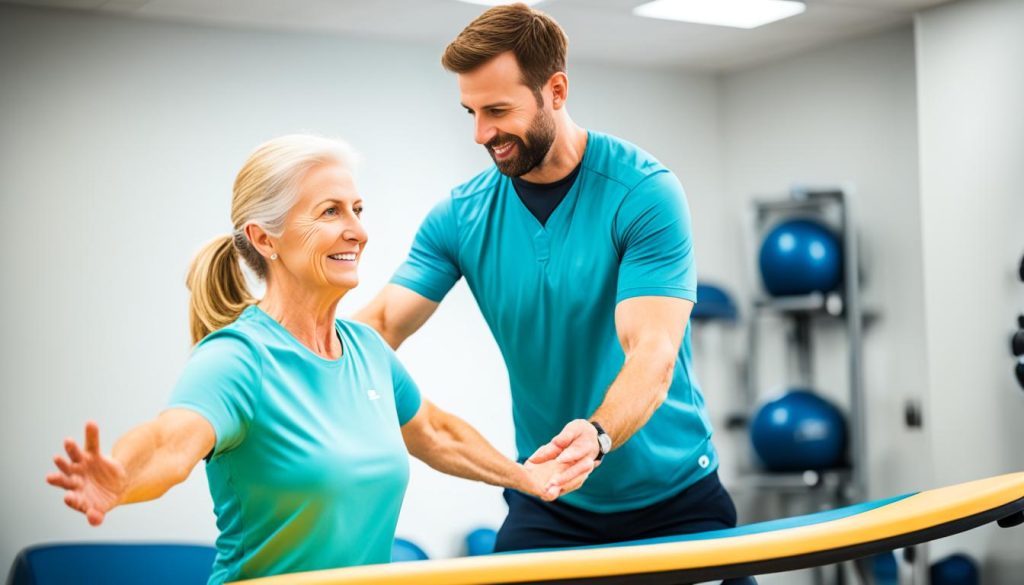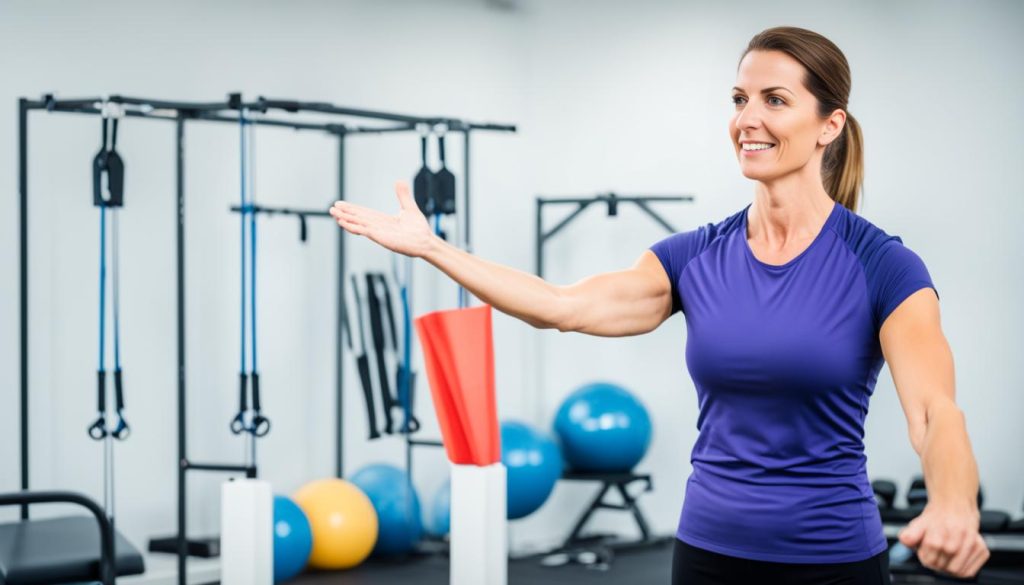Vestibular rehabilitation exercises are an essential part of treating balance and dizziness issues. These exercises aim to improve the brain’s ability to compensate for abnormalities in the vestibular or balance system. By stimulating the vestibular apparatus, the brain can learn to tolerate and interpret this type of stimulation accurately. These exercises work similarly to how skaters or dancers train to prevent dizziness when spinning rapidly. The ultimate goal is to regain balance and reduce dizziness through regular and consistent practice.
Balance exercises, vertigo exercises, and dizziness exercises are all vital components of vestibular rehabilitation. They help to strengthen the balance system and improve coordination. By incorporating vestibular therapy techniques, individuals can work towards managing their symptoms and achieving a better quality of life.
In this article, we will explore the world of vestibular rehabilitation exercises. From understanding the principles behind these exercises to knowing how to start and where to perform them, we will provide you with valuable information on harnessing the power of vestibular rehabilitation therapy. Whether you’re seeking relief from vertigo or looking to enhance your balance, these exercises can make a significant difference in your daily life.
Understanding Vestibular Rehabilitation Therapy
Vestibular rehabilitation therapy encompasses a series of exercises aimed at managing dizziness and balance issues. It is frequently utilized to treat conditions like vertigo and labyrinthitis. The primary objective of these exercises is to enhance stability and alleviate symptoms by challenging the vestibular system and training the brain to accurately interpret sensory information. This therapy often includes a combination of balance training, inner ear exercises, and specific maneuvers tailored to address vestibular dysfunction.
Balance training plays a crucial role in vestibular rehabilitation therapy. Through targeted exercises, individuals can improve their proprioception and develop a stronger sense of balance. These exercises may involve standing on one leg, walking on a narrow beam, or performing coordinated movements that challenge stability. By gradually increasing the difficulty and intensity of these activities, patients can enhance their balance and reduce dizziness.
Inner ear exercises are another key component of vestibular rehabilitation therapy. These exercises specifically target the vestibular system, which is responsible for our sense of spatial orientation and balance. By performing head movements and exercises that stimulate the inner ear, individuals can strengthen the vestibular apparatus and improve its functioning. This, in turn, helps the brain better process sensory input and reduce symptoms of dizziness and vertigo.
In addition to balance training and inner ear exercises, vestibular rehabilitation therapy may also include specific maneuvers designed to address vestibular dysfunction. These maneuvers aim to dislodge and reposition the particles in the inner ear, which can become dislodged and cause vertigo. By performing these maneuvers under the guidance of a healthcare professional, individuals can experience relief from vertigo symptoms and restore their sense of balance.
Overall, understanding vestibular rehabilitation therapy is crucial for individuals seeking to manage dizziness and balance issues. By challenging the vestibular system, training the brain to interpret sensory information accurately, and incorporating balance training, inner ear exercises, and specific maneuvers, individuals can significantly improve their balance and reduce symptoms.
Vestibular Rehabilitation Exercises at Home
It is possible to perform vestibular rehabilitation exercises at home under the guidance of a healthcare professional. These exercises typically involve head and eye movements, balance exercises, and walking activities that challenge the vestibular system. A vestibular rehabilitation exercises chart or pictures can provide visual guidance for proper technique and progression. It is important to follow the prescribed exercises and consult with a healthcare provider for individualized recommendations.
By incorporating vestibular rehabilitation exercises into your daily routine, you can effectively target the underlying causes of balance issues and dizziness. These exercises help strengthen the vestibular system and improve its ability to interpret sensory information accurately.
When starting the exercises, begin with simple movements and gradually increase the difficulty over time. Some examples of vestibular rehabilitation exercises that can be done at home include:
- Head and Eye Movements: These exercises involve moving the head in different directions while focusing on a stationary object or following a moving object with the eyes.
- Balance Exercises: Standing on one leg, walking in a straight line with eyes closed, or performing gentle rocking motions can challenge the balance system and improve stability.
- Walking Activities: Walking on uneven surfaces, changing directions abruptly, or incorporating head movements while walking can help train the vestibular system to adapt to various situations.
It’s important to note that the specific exercises and their intensity may vary depending on your condition and the guidance of your healthcare provider. Aim to perform these exercises regularly and track your progress to monitor improvement.
Remember, consistency is key when it comes to vestibular rehabilitation exercises. With time and practice, you can regain your balance and reduce dizziness, leading to increased confidence and improved overall quality of life.

Vestibular Rehabilitation Exercises in the NHS
The National Health Service (NHS) in the United Kingdom offers vestibular rehabilitation exercises as part of their treatment options for balance and dizziness disorders. These exercises are typically prescribed by healthcare professionals, such as physiotherapists, who specialize in vestibular rehabilitation. In some cases, video resources may be provided to guide patients in performing the exercises correctly. The aim is to improve balance, reduce dizziness, and enhance overall quality of life.
The NHS recognizes the importance of incorporating vestibular rehabilitation exercises into the treatment plans of individuals with vestibular disorders. These exercises are designed to challenge and strengthen the vestibular system, allowing patients to regain their balance and reduce symptoms of dizziness. They can be customized to the individual’s specific needs and can be tailored to address their unique challenges.
By working closely with healthcare professionals, patients can receive personalized guidance and support throughout their vestibular rehabilitation journey. Physiotherapists and other specialists will assess patients’ needs and create exercise programs that target their specific areas of concern. These professionals will also monitor progress and make any necessary adjustments to the exercise plan.
Vestibular rehabilitation exercises offered by the NHS may include a variety of techniques and movements. These can range from simple head and eye movements to more complex balancing exercises. Patients might be advised to perform exercises such as gaze stabilization, where they focus their eyes on stationary objects while moving their heads. They may also be instructed to practice standing on one leg or walking with their eyes closed to challenge their balance and improve their stability.
To ensure patients perform the exercises correctly and safely, the NHS may provide video resources as a visual guide. These videos can help patients understand the proper technique and positioning for each exercise, allowing them to perform the exercises effectively at home. By following the guidance of these videos, patients can maximize the benefits of their rehabilitation program and accelerate their progress towards improved balance and reduced dizziness.
Vestibular rehabilitation exercises in the NHS are an integral part of the comprehensive treatment approach for balance and dizziness disorders. By incorporating these exercises into their everyday routine, patients can actively participate in their own recovery and experience enhanced quality of life. It is important for individuals with vestibular issues to consult with their healthcare professionals to determine the most suitable exercises for their condition and to receive appropriate guidance throughout their rehabilitation journey.

Vestibular Therapy Exercises for Vertigo
Vertigo, a specific type of dizziness characterized by a spinning sensation, can be effectively treated with vestibular therapy exercises. These exercises aim to reduce the frequency and intensity of vertigo episodes by improving the brain’s ability to interpret sensory input from the vestibular system.
Specific exercises that are part of vestibular therapy include head and eye movements, balance training, and gaze stabilization exercises. These exercises are designed to challenge and stimulate the vestibular system, helping the brain to adapt and compensate for any abnormalities.
Vestibular therapy is highly individualized to meet the unique needs of each person experiencing vertigo. By tailoring the exercises to the individual’s specific condition, targeted symptom relief can be achieved. This therapy can significantly improve the quality of life for individuals living with vertigo.
Incorporating vestibular therapy exercises into a daily routine can lead to reduced vertigo symptoms, enhanced balance, and improved overall well-being. It is important to work with a healthcare professional who specializes in vestibular rehabilitation to ensure the exercises are performed correctly and safely.

By regularly practicing vestibular therapy exercises, individuals with vertigo can regain control over their balance and reduce the impact of dizziness on their daily lives. These exercises provide a natural and non-invasive approach to managing vertigo symptoms.
Benefits and Aims of Vestibular Rehabilitation Exercises
Vestibular rehabilitation exercises offer several benefits and aims for individuals with balance and dizziness issues. These exercises aid in improving the brain’s compensation for vestibular abnormalities, enhancing visual and muscle sense awareness and building confidence in everyday movements. By regularly practicing these exercises, individuals can regain their balance, reduce dizziness, and improve their overall quality of life.
One of the key benefits of vestibular rehabilitation exercises is their ability to improve the brain’s compensation for vestibular abnormalities. The vestibular system, which is located in the inner ear, plays a vital role in maintaining balance and spatial orientation. When this system is compromised, individuals may experience dizziness, vertigo, and unsteadiness. However, through targeted exercises, the brain can learn to adapt and compensate for these abnormalities, leading to improved balance and stability.
Another aim of vestibular rehabilitation exercises is to enhance visual and muscle sense awareness. These exercises often involve coordinated head and eye movements, challenging the vestibular system and improving the integration of visual and sensory information. By training the eyes to focus, track, and stabilize, individuals can improve their overall spatial awareness and visual perception, leading to better balance and reduced dizziness.

Training the Eyes and Promoting Natural Movement
Vestibular rehabilitation exercises also aim to train the eyes and promote natural movement in various environments. As part of these exercises, individuals may practice moving their eyes in specific patterns or tracking objects, which helps strengthen the connection between the vestibular and visual systems. Additionally, these exercises encourage individuals to engage in everyday movements, such as walking and turning, in both well-lit environments and relatively darker ones, like dimly lit rooms. By doing so, individuals can improve their ability to maintain balance and stability in different conditions.
Overall, vestibular rehabilitation exercises offer a holistic approach to managing balance and dizziness issues. They provide individuals with an opportunity to regain control over their movements, improve their confidence, and reduce the impact of vestibular abnormalities on their daily lives. By consistently practicing these exercises, individuals can overcome dizziness, enhance their overall balance, and enjoy a better quality of life.
How to Start Vestibular Rehabilitation Exercises?
When starting vestibular rehabilitation exercises, it is essential to consult with a healthcare professional, such as a physiotherapist or vestibular therapist. They will provide an individualized exercise plan based on the specific needs and goals of the patient.
The exercises should be performed regularly, at least three times a day, and continued for a minimum of 6 to 12 weeks or until dizziness symptoms resolve. It is important to persevere through symptoms of dizziness and discomfort during the exercises to achieve optimal results.
If you are unsure about which exercises to perform or how to do them correctly, a healthcare professional will guide you through the process. They will demonstrate each exercise and ensure you understand the correct form and technique.
Starting slowly and gradually increasing the intensity and duration of the exercises is essential. This approach allows your body and vestibular system to adjust and adapt over time.
Remember to listen to your body and take breaks when needed. Push yourself within your comfort zone but avoid overexertion or excessive strain.
An individualized exercise plan will typically include a combination of balance exercises, inner ear exercises, and specific dizziness exercises. These exercises may involve head and eye movements, coordination and balance challenges, and targeted strengthening routines.
Easing into the Exercises
When starting vestibular rehabilitation exercises, it is common to experience some initial discomfort or an increase in dizziness symptoms. This is normal and to be expected as your body adjusts to the new stimuli and challenges.
By sticking with the exercise plan and gradually increasing the difficulty and intensity, your body will adapt and improve over time. It is important to stay consistent and committed to the exercises.
If you have any concerns or questions during the process, do not hesitate to reach out to your healthcare professional. They are there to provide guidance and support throughout your vestibular rehabilitation journey.
Conclusion
Vestibular rehabilitation exercises are a valuable tool in improving balance, reducing dizziness, and enhancing overall quality of life for individuals with vestibular disorders. These exercises aim to train the brain to compensate for abnormalities in the vestibular system, improve sensory integration, and restore confidence in everyday movements.
Whether performed at home or under the care of healthcare professionals in the NHS, vestibular rehabilitation exercises offer significant benefits and aim to help individuals regain their balance and live steadier, more comfortable lives.
By incorporating balance exercises, vertigo exercises, and other vestibular therapy techniques, individuals can strengthen their vestibular system and overcome the challenges caused by dizziness and balance issues. With regular practice and guidance from healthcare professionals, vestibular rehabilitation exercises can make a substantial difference in managing vestibular disorders and improving overall well-being.

